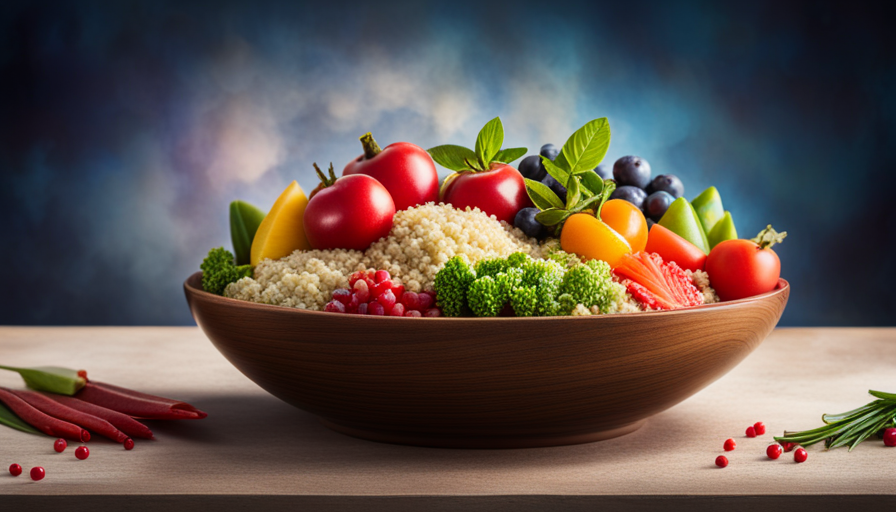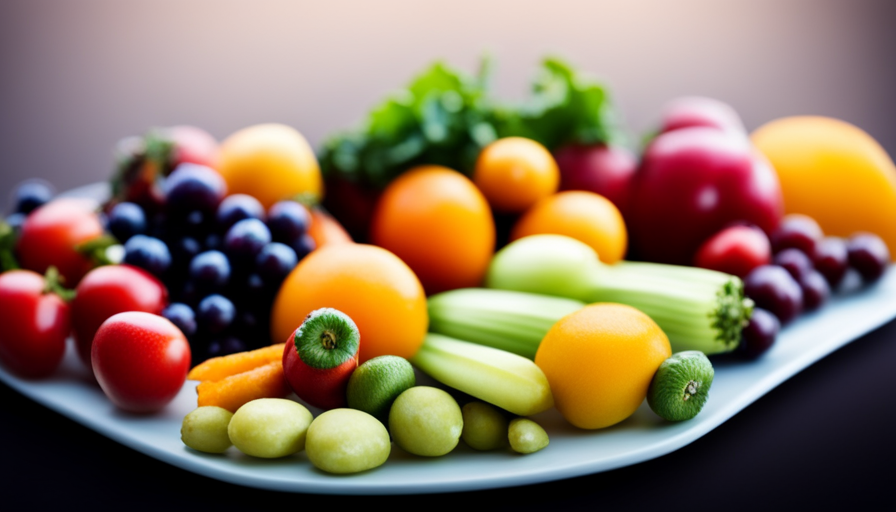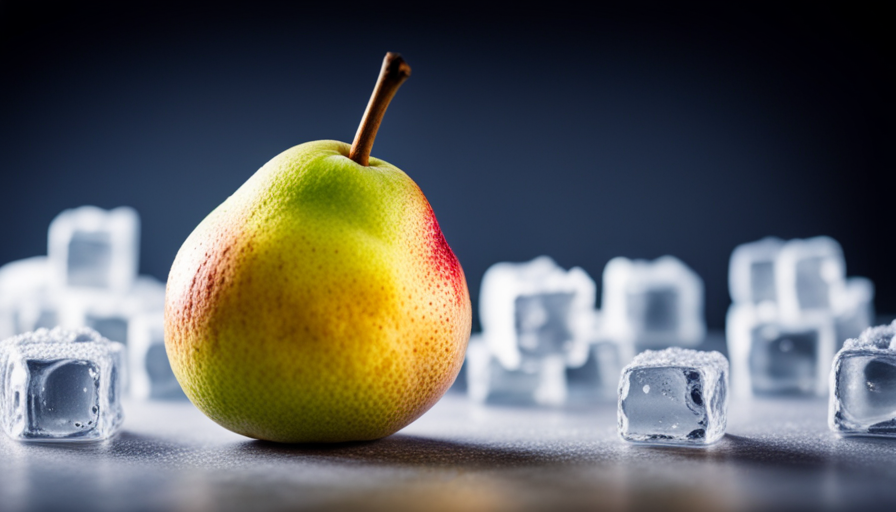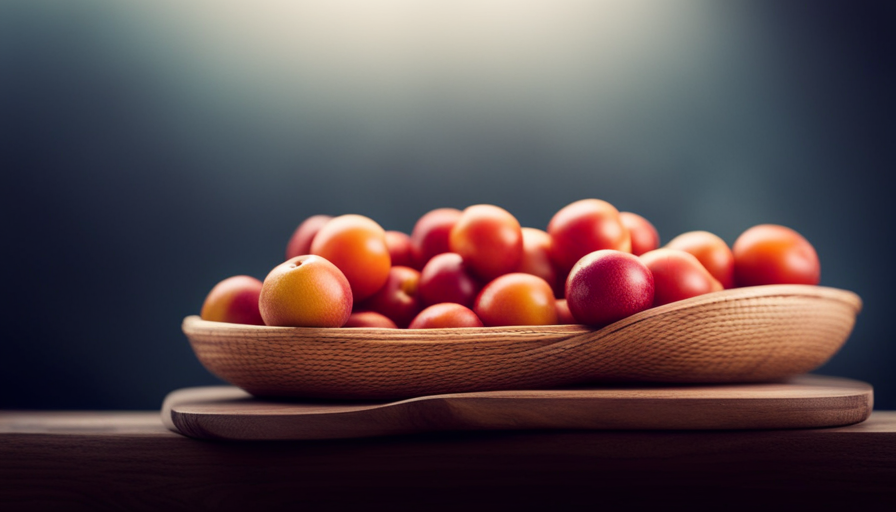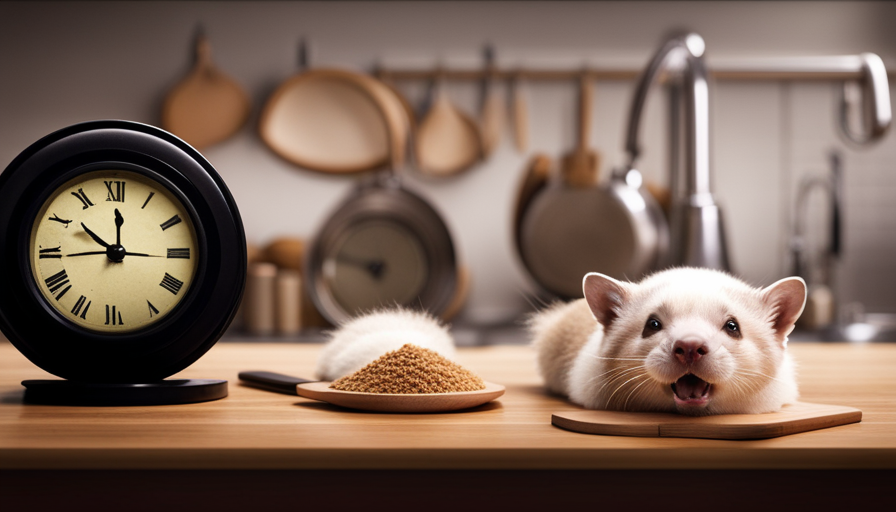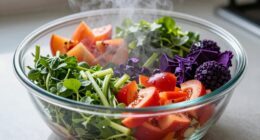Are you prepared to adopt the raw food diet and elevate your health? Get ready to be pleasantly surprised, as quinoa is set to become your new favorite food!
Yes, that’s right, the versatile and nutritious quinoa can be a delicious addition to your raw food repertoire. While quinoa is typically cooked before consumption, it can also be enjoyed in its raw form, providing you with a plethora of health benefits. From its high protein content to its abundance of essential vitamins and minerals, quinoa is a powerhouse of nutrition that can support your raw food lifestyle.
But hold on, before you dive headfirst into a bowl of raw quinoa, there are a few important things you need to know. In this article, we will explore the best ways to incorporate quinoa into your raw food diet, from soaking and sprouting techniques to mouthwatering recipes that will make your taste buds dance with joy.
So get ready to unlock the full potential of quinoa and elevate your raw food game to new heights!
Key Takeaways
- Quinoa is a versatile grain that can be enjoyed raw in a raw food diet.
- Incorporating quinoa into a raw food diet can aid in weight loss and digestion.
- Quinoa is a complete protein source, containing all nine essential amino acids.
- Quinoa can be used in a variety of dishes, including salads, wraps, porridge, and baked goods, to enhance taste and boost nutritional value.
The Benefits of Quinoa in a Raw Food Diet
If you want to boost your health while following a raw food diet, you should definitely include quinoa in your meals! Quinoa is a versatile and nutritious grain that offers many benefits for weight loss and overall well-being.
One of the main benefits of quinoa in a raw food diet is its ability to aid in weight loss. Quinoa is low in calories and high in fiber, which helps to keep you feeling full and satisfied for longer periods of time. By incorporating quinoa into your meals, you can reduce your overall calorie intake and promote weight loss.
Another way to incorporate quinoa into your raw food diet is by adding it to your smoothies and juices. Quinoa can be blended into a smoothie or juice to add a creamy texture and boost its nutritional value. It’s a great source of protein, vitamins, and minerals, making it an excellent addition to any raw food beverage.
Including quinoa in your raw food diet can provide numerous benefits, especially for weight loss. By incorporating quinoa into your meals and blending it into your smoothies and juices, you can enhance the nutritional value of your diet and support your overall health and well-being. So go ahead and start enjoying the benefits of quinoa today!
Understanding the Nutritional Profile of Quinoa
Quinoa is a nutritional powerhouse, packed with an abundance of vitamins, minerals, and antioxidants that can boost your overall well-being. This ancient grain is a great addition to a raw food diet due to its numerous nutritional benefits. It is a complete protein source, containing all nine essential amino acids, making it an excellent choice for vegans and vegetarians. Quinoa is also high in fiber, which aids in digestion and helps you feel full for longer periods, supporting weight management. Additionally, it is rich in iron, magnesium, and manganese, which are essential for energy production and maintaining healthy bones.
When incorporating quinoa into your raw food diet, there are a few cooking methods you can use. Sprouting is a popular technique as it increases the availability of nutrients and reduces anti-nutrients. To sprout quinoa, soak it in water for several hours, rinse thoroughly, and allow it to sit in a sprouting jar or tray for about a day. Another option is to make quinoa flour by grinding the grains into a fine powder. This can be used in various raw food recipes, such as making raw quinoa bread or crackers.
Overall, quinoa is a versatile and nutrient-dense ingredient that can enhance the nutritional profile of your raw food diet. By understanding its nutritional benefits and exploring different cooking methods, you can enjoy the goodness of quinoa while following a raw food lifestyle.
| Nutrient | Amount per 1 cup (185g) | % Daily Value |
|---|---|---|
| Protein | 8.1g | 16% |
| Fiber | 5.2g | 21% |
| Iron | 2.8mg | 16% |
| Magnesium | 118mg | 30% |
Soaking and Sprouting Quinoa for Maximum Nutrient Absorption
By soaking and sprouting quinoa, you can unlock its full nutritional potential and optimize the absorption of essential nutrients into your body. Sprouting is a simple technique that can significantly enhance the nutrient content of quinoa, making it even more beneficial for your health.
When you soak quinoa, you activate enzymes that break down the anti-nutrients and make the nutrients more bioavailable. This process also helps to remove the bitter saponins that naturally coat the quinoa seeds.
To sprout quinoa, start by rinsing the seeds thoroughly to remove any residue. Then, place the quinoa in a bowl and cover it with water. Let it soak for at least 4 hours or overnight. After soaking, drain the water and rinse the quinoa again.
Place the seeds in a sprouting tray or a jar covered with a breathable cloth. Rinse the quinoa twice a day for the next 2-3 days, ensuring that it stays moist but not waterlogged. You will start to see tiny sprouts emerging from the seeds.
Once your quinoa is sprouted, you can use it in a variety of nutrient-rich salads. Combine it with fresh vegetables like tomatoes, cucumbers, and bell peppers, along with some leafy greens like spinach or kale. Add a dressing of your choice and enjoy a delicious and nutritious meal.
Sprouted quinoa not only provides you with essential nutrients but also adds a delightful crunch to your salads. So, give sprouting a try and elevate your quinoa experience to a whole new level of health and flavor.
Creating Quinoa-Based Salads and Bowls
Once your quinoa’s sprouted, get creative and whip up a variety of mouthwatering salads and bowls that’ll leave your taste buds dancing with joy.
Quinoa-based salads aren’t just delicious but also packed with nutrients. You can combine cooked quinoa with an array of fresh veggies like cherry tomatoes, cucumber, and bell peppers. Add some diced avocado or feta cheese for extra creaminess and flavor. To enhance the taste, drizzle a tangy vinaigrette made with lemon juice, olive oil, and herbs over your salad.
If you prefer a heartier meal, try making quinoa stuffed bell peppers. Cut the tops off the bell peppers, remove the seeds, and stuff them with a mixture of cooked quinoa, sautéed onions, garlic, and your choice of protein like black beans or grilled chicken. Top it off with some grated cheese and bake until the peppers are tender and the cheese is melted and golden.
For a refreshing breakfast option, consider quinoa-based smoothie bowls. Blend cooked quinoa with your favorite fruits like bananas, berries, and mango. Add a splash of almond milk or coconut water to achieve the desired consistency. Top your smoothie bowl with fresh fruits, nuts, and a drizzle of honey for added sweetness.
These quinoa-based salads and bowls aren’t just satisfying but also a great way to incorporate quinoa into your raw food diet. Experiment with different combinations and flavors to find your favorite quinoa creations. Enjoy the nutritious benefits and the delightful taste of these dishes!
Making Quinoa Porridge for a Warm and Filling Breakfast
Indulge in a cozy and comforting breakfast that’ll warm your soul and keep you satisfied all morning long – make yourself a steaming bowl of quinoa porridge. Not only is quinoa porridge delicious, but it’s also packed with nutrients that’ll kickstart your day on a healthy note.
Here are four variations of quinoa porridge that you can try:
-
Classic Quinoa Porridge: Cook quinoa in water or your choice of milk until it turns creamy and soft. Add a pinch of salt and sweeten with your preferred natural sweetener, like honey or maple syrup.
-
Apple Cinnamon Quinoa Porridge: Add diced apples and a sprinkle of cinnamon to your quinoa porridge while it cooks. The combination of warm spices and sweet apples will give your breakfast a delightful flavor.
-
Berry Bliss Quinoa Porridge: Add a handful of your favorite berries, like blueberries or strawberries, to your cooked quinoa porridge. Berries are rich in antioxidants and will add a burst of freshness to your morning meal.
-
Tropical Quinoa Porridge: Add diced tropical fruits like mango, pineapple, and coconut flakes to your quinoa porridge. This variation will transport you to a tropical paradise with every bite.
By adding fruits to your quinoa porridge, you not only enhance the taste but also boost the nutritional value. Fruits provide essential vitamins, minerals, and fiber to keep you energized throughout the day.
So, start your day right with a bowl of warm and filling quinoa porridge and enjoy the endless possibilities with these delicious variations.
Incorporating Quinoa into Raw Food Wraps and Rolls
Spice up your wraps and rolls with the unexpected addition of quinoa, turning your ordinary meal into a vibrant and tantalizing experience. When it comes to raw food wraps, quinoa can add a satisfying crunch and a boost of nutrition.
Quinoa is a complete protein, meaning it contains all nine essential amino acids that our bodies need. It’s also rich in fiber, vitamins, and minerals, making it a great addition to any raw food diet.
To incorporate quinoa into your raw food wraps, start by cooking the quinoa according to the package instructions. Once cooked, let it cool before mixing it with your favorite raw vegetables and herbs. You can also add a splash of lemon juice or a drizzle of olive oil for added flavor. Spread the mixture onto large lettuce leaves or collard greens, and roll them up tightly.
Another way to enjoy quinoa in your raw food wraps is by using quinoa rolls. Simply spread a layer of quinoa on a sheet of nori seaweed, and then add your desired fillings, such as sliced avocado, cucumber, and bell peppers. Roll it up tightly and slice into bite-sized pieces. The combination of the crispy nori, creamy avocado, and nutty quinoa creates a delicious and nutritious snack or meal.
Incorporating quinoa into your raw food wraps and rolls not only adds texture and flavor but also provides a nutritious and filling component to your meal. So go ahead and experiment with different combinations of vegetables, herbs, and spices to create your own unique quinoa-filled creations.
Using Quinoa Flour in Raw Desserts and Baked Goods
Boost your dessert game with the unexpected twist of quinoa flour, adding a nutritious and wholesome element to your favorite sweet treats. Quinoa flour is a versatile ingredient that can be used to enhance the flavor and texture of raw cookies and other baked goods. It is gluten-free and packed with protein, fiber, and essential nutrients, making it a healthier alternative to traditional flours.
One way to use quinoa flour in raw desserts is by incorporating it into cookie recipes. Simply replace a portion of the regular flour with quinoa flour to add a nutty and slightly earthy flavor. The quinoa flour will also provide a soft and chewy texture to the cookies. You can experiment with different flavors by adding ingredients such as chocolate chips, dried fruits, or nuts.
Another creative way to use quinoa flour is by exploring quinoa-based smoothie bowls. Blend together frozen fruits, your choice of milk or yogurt, and a spoonful of quinoa flour for a nutritious and filling breakfast or snack. The quinoa flour will add a creamy consistency to the smoothie bowl while giving it a boost of protein and fiber.
Incorporating quinoa flour into your raw desserts and baked goods is a great way to add a nutritious twist to your favorite sweet treats. Whether you’re making raw cookies or exploring quinoa-based smoothie bowls, this versatile ingredient will elevate your dessert game while providing essential nutrients. So why not give it a try and enjoy the benefits of quinoa flour in your next dessert creation?
| Quinoa Flour Benefits |
|---|
| Gluten-free |
| High in protein |
| Rich in fiber |
| Packed with nutrients |
| Versatile ingredient |
Quinoa as a Protein Source in Raw Food Recipes
Now that you know how to use quinoa flour in raw desserts and baked goods, let’s explore another way to incorporate this nutritious grain into your raw food diet.
Quinoa is not only a great source of fiber and essential minerals, but it’s also a complete protein, containing all nine essential amino acids. This makes it an excellent choice for those following a raw food diet, as it can help meet your protein needs.
One delicious way to include quinoa in your raw food recipes is by incorporating it into your breakfast routine. You can use cooked quinoa as a base for a hearty and filling breakfast bowl, topped with fresh fruits, nuts, and a drizzle of honey or maple syrup.
Another option is to add cooked and cooled quinoa to your smoothies for an extra protein boost. This won’t just make your smoothies more satisfying but will also provide sustained energy throughout the day.
By incorporating quinoa into your breakfast recipes and smoothies, you can ensure that you’re starting your day off with a balanced and nutrient-rich meal. So, why not give these quinoa breakfast recipes and smoothie ideas a try and experience the benefits for yourself?
Quinoa-Based Energy Bars and Snacks
One delicious option for incorporating quinoa into your snack routine is by making homemade energy bars or snacks. Quinoa is not only a great source of protein, but it is also packed with essential nutrients and antioxidants. By using quinoa as a base for your energy bars or snacks, you can create a satisfying and nutritious treat.
Quinoa-based energy bars are easy to make and can be customized to your liking. You can add a variety of ingredients such as nuts, seeds, dried fruits, and even chocolate chips for a touch of sweetness. These bars can be enjoyed as a quick on-the-go snack or as a pre or post-workout fuel.
Another option is to make quinoa-based granola bars. These bars are perfect for a quick breakfast or a mid-afternoon pick-me-up. They can be made with a combination of oats, quinoa, nuts, and dried fruits. You can also add a drizzle of honey or maple syrup for some extra sweetness.
To give you some inspiration, here is a table showcasing two delicious quinoa-based snack recipes:
| Recipe Name | Ingredients |
|---|---|
| Quinoa-Based Smoothie | 1 cup cooked quinoa, 1 banana, 1 cup spinach, 1 cup almond milk, 1 tablespoon honey |
| Quinoa-Based Granola Bars | 1 cup cooked quinoa, 1 cup oats, 1/2 cup almond butter, 1/4 cup honey, 1/4 cup dried fruits, 1/4 cup nuts |
Incorporating quinoa into your snack routine can not only add a delicious twist to your snacks but also provide you with a boost of protein and nutrients. Give these quinoa-based energy bars and granola bars a try and enjoy a healthy and satisfying snack!
Tips for Storing and Preserving Quinoa in a Raw Food Kitchen
To ensure your quinoa stays fresh and ready to use in your kitchen, remember to store it in an airtight container in a cool, dry place. Proper storage is essential for preserving quinoa’s taste and texture.
Here are some tips for storing and preserving quinoa in a raw food kitchen:
-
Keep it airtight: Use a sturdy, airtight container to prevent moisture and air from spoiling your quinoa. Mason jars or food-grade plastic containers work well.
-
Store in a cool, dry place: Quinoa is sensitive to heat and humidity, which can lead to spoilage. Choose a cool, dry spot in your kitchen, away from direct sunlight or heat sources like stoves or ovens.
-
Avoid moisture: Moisture can cause quinoa to clump or become moldy. Make sure the container and the quinoa itself are completely dry before storing.
-
Label and date: It’s easy to forget how long you’ve had a particular batch of quinoa. Labeling the container with the date of purchase or expiration can help you keep track and ensure freshness.
-
Rotate stock: Quinoa has a relatively long shelf life, but it’s still a good practice to rotate your stock. Use older quinoa first to ensure you’re always using the freshest batch.
By following these tips, you can store and preserve your quinoa properly, ensuring it stays fresh and tasty for longer periods in your raw food kitchen.
Frequently Asked Questions
Can I eat quinoa raw without soaking or sprouting it?
Yes, you can eat quinoa raw without soaking or sprouting it. However, it’s recommended to soak quinoa before consuming it raw. Soaking helps remove the natural coating called saponin, which can give quinoa a bitter taste. Soaking also increases digestibility and nutrient absorption. If you prefer not to soak it, try adding quinoa to salads or smoothies to enjoy its raw benefits. Experiment with raw quinoa recipes to find what suits your taste buds.
Are there any negative effects of consuming quinoa on a raw food diet?
Consuming quinoa on a raw food diet can have both negative effects and health benefits. On the negative side, quinoa contains phytic acid, which can inhibit the absorption of certain minerals. However, soaking or sprouting quinoa can help reduce phytic acid levels.
On the positive side, quinoa is a good source of protein, fiber, and essential nutrients. It also has antioxidant and anti-inflammatory properties. So, while there are some potential drawbacks, incorporating soaked or sprouted quinoa into your raw food diet can provide valuable nutrition.
Can I substitute quinoa with other grains in raw food recipes?
Looking for a quinoa substitute in raw food recipes? You’re in luck! There are plenty of grain options that can add a delicious twist to your meals. From nutty amaranth to hearty buckwheat, these alternatives bring a variety of flavors and textures to your raw food diet.
Incorporating different grains not only diversifies your meals but also boosts your nutrient intake. So go ahead, get creative and explore the benefits of incorporating these grains into your raw food lifestyle!
How long does it take to sprout quinoa for maximum nutrient absorption?
To maximize nutrient absorption, sprouting quinoa is a great option. The sprouting time for quinoa is typically around 2 to 4 hours.
Sprouting quinoa not only enhances its nutritional value but also makes it easier to digest. During the sprouting process, enzymes are activated, which break down anti-nutrients and increase the bioavailability of nutrients like vitamins, minerals, and antioxidants.
So, by sprouting quinoa, you can reap the benefits of improved nutrient absorption and enhanced digestion.
Can I store cooked quinoa in the fridge for a few days and still maintain its nutritional value?
Yes, you can store cooked quinoa in the fridge for a few days and it will still maintain its nutritional value, but only if you want to experience a burst of energy like never before! The nutritional value of quinoa remains intact even after being cooked and stored, making it a convenient option for meal prepping.
So go ahead and enjoy your cooked quinoa while reaping all its nutritious benefits, just be prepared for a deliciously nutritious explosion in your body!
Can Quinoa be Included in a Raw Food Diet for Chrons?
Yes, quinoa can be included in a raw food diet for Chrons. While some people with Chrons disease may have difficulty digesting certain raw foods, quinoa is often well-tolerated. It is packed with nutrients and can be prepared in a variety of ways to suit a raw food diet for Chrons.
Conclusion
Congratulations! You’ve learned all the amazing ways to incorporate quinoa into your raw food diet. By soaking and sprouting quinoa, you unlock its full nutrient potential.
From refreshing salads to warm and filling porridge, quinoa offers endless possibilities. Don’t forget to try using quinoa flour in your raw desserts for a delightful twist.
With quinoa as your protein source, you can fuel your body with the energy it needs. And let’s not forget about those delicious quinoa-based energy bars and snacks!
Remember to store and preserve your quinoa properly to keep it fresh and ready for your next culinary adventure. So go ahead, embrace the wonders of quinoa and enjoy a vibrant, nourishing raw food lifestyle!

